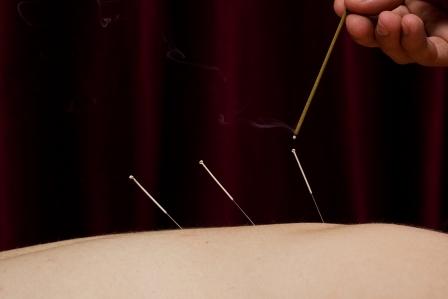
The heat and warmth from Moxibustion is the best form of treatment for Damp. It originated in Northern China in the bitterly cold climate of Mongolia.
A cold and harsh environment is one of the causes of Damp which invades the body via the meridian network. By causing a literal obstruction and congesting the digestive organs, it saps the body of its Qi.
Moxibustion has always been an integral part of Chinese medical practice as indicated by the Chinese characters for ‘acupuncture’, which are Zhen Jiu. Their original meaning is ‘needle moxibustion.’
It is important for Western acupuncture practitioners to incorporate Moxibustion into their treatments otherwise patients are missing out on the full potential benefits of this treatment. (AcupunctureTreatment.com)
Moxibustion reinvigorates the flow of Qi by stimulating the three burners of the lungs, spleen and kidneys. This article will highlight why practitioners use certain acupuncture points in this treatment.
Moxibustion and Spleen 6 (SP 6)
This is a key acupuncture point commonly used in Moxibustion. It is located on the inside of the lower leg – the tibia.
It is the point where the spleen, liver and kidney meridians meet. The spleen and the liver are essential for the proper conversion of food into energy. The kidneys aid the intestines in the removal of harmful waste from the body.
Spleen 6 helps to clear these three channels which play an important role in general well-being and the prevention of diseases. The benefits of using this acupuncture point include successful treatment of digestive problems such as diarrhoea, bloating, undigested food and poor appetite. These are some of the symptoms of Damp.
Such is the potency of Spleen 6 that it even has beneficial effects on the reproductive health in both women and men.
Using Moxibustion at Stomach Leg 36 (ST36)
This is another highly useful acupuncture point in Moxibustion. It is located in the belly of the muscle which runs down the outer edge of the tibia, below the knee and under the boney protruberanc at the top of the tibia.
A Chinese monk, Kenso Yoshida (c.1330) claimed that this point was vital for the maintenance of good health and a long life. He recommended that anyone over the age of 40 should have moxibustion on this point every day. (Source: China.org.cn)
As Stomach 36 is the ‘source’ point of the stomach, the warmth of Moxibustion at this point harmonises the Spleen and Stomach to regulate and balance digestion. This enables the digestive system to disperse Damp which would otherwise cause poor digestion, mental fatigue and depleted Qi energy.
Boosting the Stomach and Spleen with Moxibustion also counteracts the detrimental effects of too much worrying and stress which tend to congest the digestive system. By boosting the Spleen, which is also part of the immune system, moxa at ST36 also boosts that entire system.
Stomach 25 (ST25) and Moxibustion
This point is located on the abdomen close to the navel.
Moxibustion here can heal the effects of Cold and Damp in the large intestines. Symptoms of Cold and Damp include diarrhoea, bloating and sometimes pain in the bowels.
This is usually diagnosed in Western medicine as IBS. Only the symptoms of what is called IBS tend to be treated as it is little understood. Chinese Traditional Medicine (CTM) has a more holistic understanding of these symptoms having their root in deficiency in the Qi in the liver. This has a knock on effect on the efficiency of the spleen.
Moxibustion at ST25 brings the Qi back into balance and regulates the intestines, spleen and stomach.
Another acupuncture point used in Moxibustion that has a similar benefit is Liver 13.
Evidence of Further Benefits of Direct Moxibustion
Finally here are some statistics to support the benefits of moxibustion. (Found on www.jcrows.com/moxaarticles.html)
Direct Moxibustion improves the circulation of blood and the lymphatic system. This means that in the long term it is a more effective treatment for chronic illnesses than acupuncture alone. The body is encouraged to drain itself of waste and transport vital oxygen and nutrition to the organs more efficiently.
There is also evidence that direct Moxibustion increases the production of white blood cells. White blood cells are the body’s defence against disease. The number of white blood cells in the body remains elevated 4 – 5 days after treatment.
The amount of red blood cells and haemoglobin in the body also increases as a result of direct Moxibustion. Tests show that patients with a ratio of 78% of red blood cells and haemoglobin in their blood before treatment had a ratio of up to 90% after treatment.
With the increase in the presence of these little carriers of oxygen, the overall energy levels and sense of well-being that a person feels after treatment is greatly boosted.
Image Purchased from SentientPhotos / www.BigStock.com







